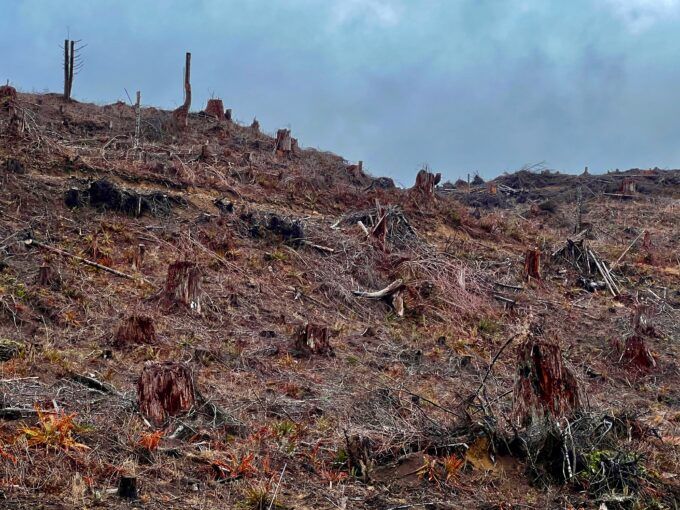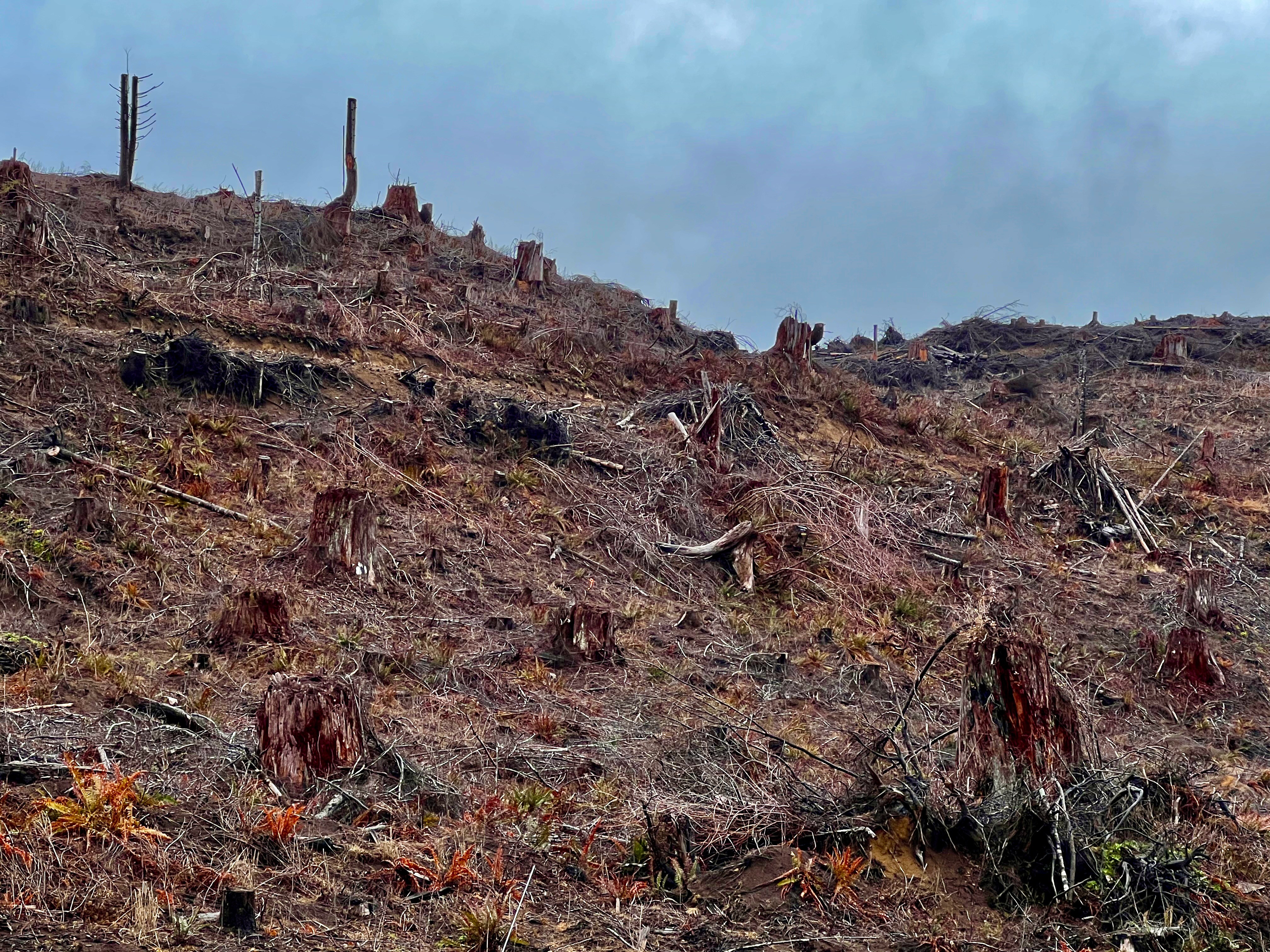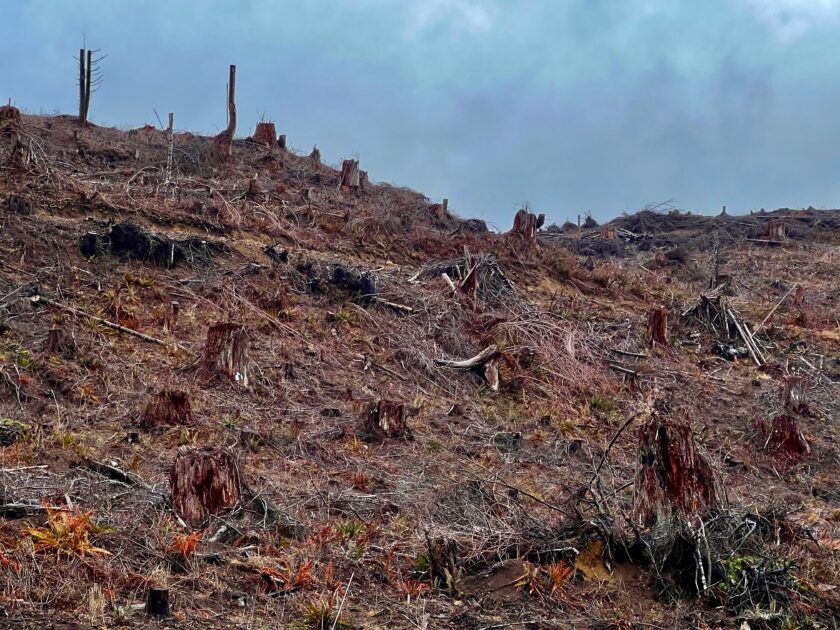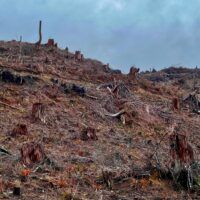






























































Cleacut adjacent to the Dark Divide Roadless Area, Gifford Pinchot National Forest, Washington Cascades. Photo: Jeffrey St. Clair.
The Trump Administration recently promised to bring “common sense management of our natural resources” to 58 million acres of roadless public lands mostly in the West. Translation: we’re going to build more roads and cut down a lot of trees in many of the most remote and beautiful places left in the country, wreaking havoc on the land’s other resources, like water and wildlife and recreation, including hunting and fishing.
Trump’s Orwellian version of common sense ignores the hard-earned lessons of decades of experience managing our national forests, experience that led eventually in the late 1990’s to the truly common sense decision that the best way to manage these remaining roadless, undeveloped lands was to simply leave them be and prohibit the building of roads and logging.
There are reasons that these lands remained roadless into the late 90’s, surviving unscathed through the mid-century decades of over harvesting on the national forests when the Forest Service served mainly as a timber cutting agency. Then came the environmental movement and the major environmental legislation of the 60’s and 70’s, the National Forest Management Act, the National Environmental Policy Act, the Clean Water Act, the Endangered Species Act, the Wilderness Act and more. These laws grew out of the burgeoning awareness of the many values that forests provide other than saw logs, even as the endless frontier of the American West and the attitudes that went with it were rapidly waning. More people began to pay attention to what went on in the back woods, and the Forest Service began to change its management practices to take into consideration all those other values the forests provide. The agency didn’t change its ways overnight, or even willingly in many cases. Lawsuits were filed challenging Forest Service plans and actions and court decisions were reached, interpreting the meaning of the new laws and how they applied to forest management practices.
As the value of resources other than timber came into clearer focus, the economics of cutting timber also came under greater scrutiny. The 58 million remaining roadless acres protected by the roadless rule in the late 90’s were still roadless largely because they were simply the least economically feasible places to cut timber. This is due in part to their remoteness but also to the fact that most of these sites are just not the best places to grow trees for commercial purposes. And this is before you even begin to factor in the value of the other resources these lands provide that would be harmed by timber harvesting and road building. This process of learning to balance the values of all the resources (multiple use management) led eventually to the roadless rule.
The simple fact is that by the 70’s the vast majority of the best growing sites had already been cut. In the 70’s, a major controversy arose over the Forest Service practice of subsidizing the timber industry by paying for the construction of the roads that made harvesting possible. Many of the agency’s timber sales were not economically feasible for the timber companies without these subsidies. You heard that right. Without the public paying to build the roads and ravage the water resources and the hunting and fishing and hiking, the timber companies wouldn’t have been able to make a buck cutting down the trees. They would not have entered those areas on their own.
This was especially true in places away from the temperate rain forest that covers the coastal mountains of the Pacific Northwest, where trees grow huge and they grow fast with abundant rain and perfect growing climate. Take much of the State of Idaho, where I worked as a newspaper reporter covering the Forest Service and natural resource and public land issues for 13 years in the late 70’s and 80’s. Idaho is the most mountainous state in the union, by percentage of surface area covered by mountains. North of the Snake River Plain in southern Idaho that makes up the state’s major agricultural area (think potatoes), the state is mostly mountains all the way to Canada.
There are lots of trees in those mountains, but most of the state is a much dryer climate than the coast, except the far north. There are some big ponderosa pines back in the canyons of the Salmon River, for instance, but many of those forests took hundreds of years to grow. So if you were to go in and cut those forests, particularly those on hotter south facing slopes, it would take several human lifetimes to grow them back, if you could achieve forest regeneration in the first place, which would take favorable conditions of rain and heat, far less likely to occur now in the time of climate change warming.
And if you build all those roads in the granitic soils of the Idaho Batholith geological region, what’s very likely to happen is what happened on the South Fork of the Salmon River after the Forest Service first started building roads and cutting timber in the drainage from the 1940’s to the 60’s. During that era, a very large rain on snow flooding event washed all those soils fractured by the road construction down into the river, burying the salmon spawning beds in layers of sediment and nearly wiping out one of the most important salmon runs in the state.
Much of central Idaho and the Salmon River drainage will be protected from the Trump administration’s attempt to overturn the protections granted to these roadless areas, because it is the location of two of the largest designated wilderness areas in the lower 48, the Frank Church River of No Return Wilderness (2.367 million acres) and the Selway-BItterroot Wilderness (1.340 million acres). Designated wilderness areas are created by acts of Congress and thus are not subject to national forest rule-making and practices. By law they cannot be developed. But much of Idaho’s roadless terrain does not have this extra level of protection. These lands are protected only by the roadless rule, and this is what the Trumpers are going after.
Trump’s Agriculture Secretary Brooke Rollins, a Texan with no apparent experience with forest management, called the roadless rule outdated. She claimed further that Trump is removing “absurd obstacles to common sense management of our natural resources” while opening “a new era of consistency and sustainability for our nation’s forests.”
When Rollins talks about consistency and sustainability, she apparently is not aware that sustainability in terms of national forest timber management means attempting to manage for “sustained yield” of timber, an even and consistent flow of timber products that can be maintained in perpetuity. Her plans for opening up the roadless areas will no doubt result in what we now call resource extraction but we used to call rape, ruin and run. It is highly likely to result in subsidized road building entry to wild lands and one-off timber harvesting. The annual timber harvest on many national forests in the West is much lower than during the heyday of the timber free for all because, in addition to the new found consideration for the value of other resources, those levels of harvesting were eventually determined to be unsustainable.
Subsequent harvests (sustained yield), if possible at all, could only happen on many of the vulnerable remaining roadless areas if investments were made in timber re-planting and road maintenance. The Forest Service, by the way, already has a massive backlog in its maintenance of the tens of thousands of miles of roads that already carve up the national forests. And the costs of all forms of ongoing management just add to the common sense decision not to cut timber in these places. Even if you wanted to manage many of these areas for the maximum sustained harvest, the yield and thus profit wouldn’t be enough to offset all the costs of managing these lands for timber.
The Trumpers are also trying to manipulate the current forest fire prevention paranoia and fantasy as added justification for entering these roadless areas. They claim “thinning” the forests will help prevent forest fires as an added benefit. Of course they are ignoring the fact that intact forest canopies are more successful at preventing fires than logged over areas. An intact forest canopy lets in less heat and wind which dry out the forest and make it more fire prone. Furthermore, attempting intensive ongoing fire prevention management of this kind over vast areas would only require more time and money, which no one is going to pay for in these remote areas. Controlled burning is expensive and risky (see recent blunders in New Mexico and the North Rim of the Grand Canyon). And while we’re on the subject, indigenous peoples practiced burning in limited areas for specific reasons. They were not out regularly burning tens of millions of acres of remote forests in order to prevent fires.
Of course Rollins wants to present “absurd obstacles” like the roadless rule as some kind of WOKE approach to managing resources, some modern, weirdly contrived, nonsensical way of looking at real, down to earth situations. Forget about the history of how that rule came into being. And don’t tell that to the people of Idaho, one of the most conservative states in the Union, where a Democrat like Frank Church could never get elected today and where calling someone WOKE is fightin’ words. The good people of Idaho don’t want their wild areas desecrated. Idahoans love them some hunting and fishing and wild places. The national forests are where the locals go to hunt and fish and play. The national parks are full of too many tourists.
Rollins and Trump don’t seem to understand that relation and attachment to place is an ancient, fundamental human characteristic. When they look at our wild lands, the only thing they see is dollar signs resulting from the extraction of resources, and they won’t look back to see the destruction. They want to take us back to the good old days of rape, ruin and run.
But the people of Idaho and the rest of the West’s areas that border on the wild live there not in spite of its wild nature but because of it. These wild lands are a part of their identity. If it were all just turned into one big tree farm (or worse), the land would never be the same, and neither would they.
The post The Return of Rape, Ruin and Run to the National Forests appeared first on CounterPunch.org.
This post was originally published on CounterPunch.org.